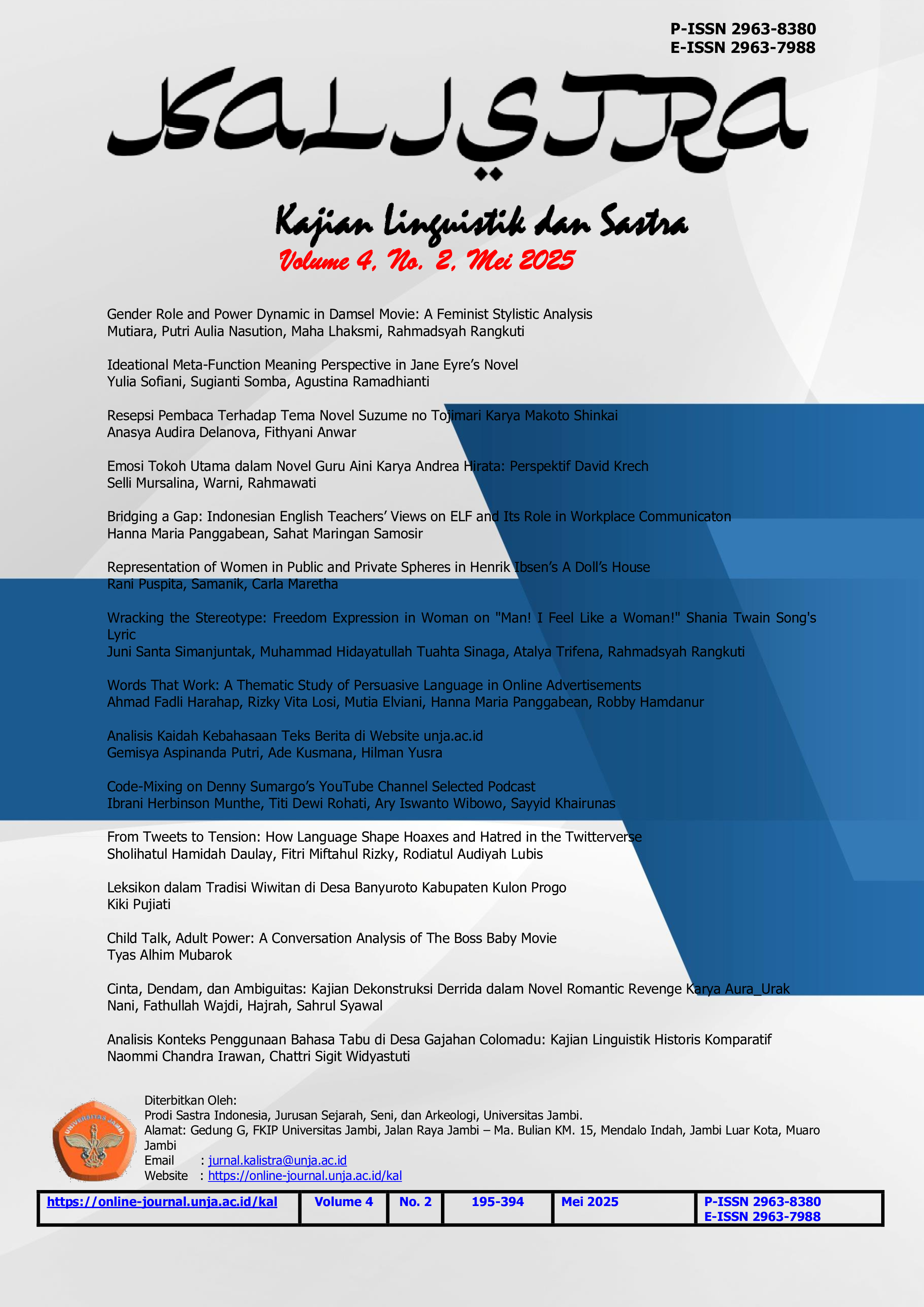Resepsi Pembaca Terhadap Tema Novel Suzume no Tojimari Karya Makoto Shinkai
DOI:
https://doi.org/10.22437/kalistra.v4i2.43462Keywords:
Suzume no Tojimari, Teori Resepsi, Sastra, novelAbstract
Pembaca memiliki peran penting dalam memaknai karya sastra, karena setiap individu membawa pengalaman pribadi serta latar sosial-budaya yang berbeda dalam proses pembacaan. Suzume no Tojimari, sebuah novel karya Makoto Shinkai, mengangkat tema kehilangan, trauma, dan harapan pascabencana yang memicu beragam respons dari pembaca di platform bookmeter.com. Penelitian ini bertujuan untuk menganalisis resepsi pembaca terhadap tema-tema utama dalam novel tersebut, khususnya terkait bencana alam, refleksi kehidupan, harapan, masa depan, dan hubungan antarindividu. Menggunakan metode deskriptif kualitatif dengan pendekatan teori resepsi sastra Hans Robert Jauss, penelitian ini menemukan bahwa pembaca tidak hanya mengikuti alur cerita, tetapi juga mengaitkannya dengan pengalaman hidup masing-masing. Hasil ini menunjukkan bahwa karya tersebut menjadi ruang dialog aktif antara teks dan pembaca serta mempertegas fungsi sastra sebagai medium reflektif yang partisipatif. Penelitian ini juga memperlihatkan pentingnya pendekatan resepsi dalam memahami keterlibatan emosional pembaca terhadap karya sastra kontemporer.
Abstract
Readers play an essential role in interpreting literary works, as each individual constructs meaning through personal experience and sociocultural background. Suzume no Tojimari, a Japanese novel by Makoto Shinkai, explores themes of loss, trauma, and post-disaster hope, which have elicited diverse responses from readers on the digital platform bookmeter.com. This study aims to analyze how readers perceive the novel’s central themes, especially natural disasters, reflections on life, hope, the future, and interpersonal relationships, by employing a descriptive qualitative method and Hans Robert Jauss's reception theory. The findings reveal that readers engage not only with the plot but also relate it to their own life experiences, turning the novel into a dynamic dialogical space between text and reader. This study also highlights the significance of the reception approach in understanding readers’ emotional engagement with contemporary literary works.
Downloads
References
Ahmadi, A. (2019). Metode Penelitian Sastra. Penerbit Graniti.
Agustin, E. N., Fitrah, Y., & Wulandari, S. (2022). Tanggapan pembaca terhadap novel ‘00.00’ karya Ameylia Falensia. KALISTRA: Kajian Linguistik dan Sastra.
https://doi.org/10.22437/kalistra.v1i1.18754
Alfian, M., Prihandari, I., Efrizal, & Zuliastutik, H. (2024). Fukugoudoushi dalam Novel Suzume no Tojimari. AYUMI: Jurnal Budaya, Bahasa dan Sastra, 11(1), 105–118. https://doi.org/10.25139/ayumi.v11i1.8530
Anggraini, T. R. (2017). Struktur Lahir Kumpulan Puisi Deru Campur Debu Karya Chairil Anwar. LENTERA: Jurnal Ilmiah Kependidikan, Vol. 1 , 77-88.
Djauhari, A., Malabar, S., & Masie, R. S. (2023). Resepsi Pembaca terhadap Novel Bercinta dalam Tahajjjudku Karya Anshela. Jurnal Ideas: Pendidikan, Sosial dan Budaya. 9(3),987-996 https://doi.org/10.32884/ideas.v9i3.1194
Endraswara, S. (2013). Metedologi Penelitian Sastra: Epistemologi Model Teori dan Aplikasi. Center Of Academic Publishing Service.
Ichsani, F. N. (2023). Resepsi Pembaca Terhadap Novel Kimi No Na Wa Karya Makoto Shinkai. Universitas Hasanuddin.
Intan, T., & Gumilar, T. (2018). Tanggapan dan horizon harapan pembaca terhadap Le Petit Prince karya A. De Saint-Exupery: Tinjauan resepsi sastra. Metahumaniora: Jurnal Penelitian Sastra, 8(3), 300-311.
https://doi.org/10.24198/metahumaniora.v8i3.20709
Iser, W. (1978). The Act of Ending: A Theory of Aesthetic Response. London & Hanley: The Johns Hopkins Universiry Press.
Jauss, H. R. (1975). Teori Estetik Sastra. Jakarta: Dunia Pustaka Jaya.
Junus, A. (1985). Resepsi Sastra. PT Gramedia.
Khanza, P. K., & Asnawi, A. (2024). Analisis Struktural dalam Novel "Jelatik" Karya Riki Utomi. Jurnal Bima: Pusat Publikasi Ilmu Pendidikan Bahasa dan Sastra, 2(2), 262-274. https://doi.org/10.61132/bima.v2i2.866
Ratna, N. M. (2009). Beberapa Teori Sastra. Pustaka Pelajar.
Risman, Y. E., & Arif, N. U. (2025). Resepsi Pembaca pada Situs Daring terhadap Novel Yukiguni Karya Kawabata Yasunari. Bina Bahasa: Jurnal Ilmiah Kebahasaan dan Kesastraan., 16(1), 1-12.
https://doi.org/10.33557/gjb0my06
Pradopo, R. D. (2013). Beberapa Teori Sastra Metode Kritik dan Penerapannya. Pustaka Pelajar.
Putri, W., Mursalim., & Dahlan, D. (2020). Tanggapan Remaja Di Samarinda Terhadap Novel Populer Jingga Dan Senja Karya Esti Kinasih: Kajian Resepsi Sastra. Ilmu Budaya: Jurnal Bahasa, Sastra, Seni, dan Budaya, 4(2), 201-210. http://dx.doi.org/10.30872/jbssb.v4i2.2662
Segerrs, R. T. (2000). Evaluasi Teks Sastra. Adicit
Shinkai, M. (2022). すずめの戸締まり(Suzume no Tojimari). Kadokawa Sneaker Bunko.
Supriyanto, A., Astuti, C. W., & Munifah, S. (2023). Analisis Struktural Novel Tempat Paling Sunyi Karya Arafat Nur. Leksis: Jurnal Pendidikan Bahasa Dan Sastra Indonesia, 3(1), 1–10. Diambil dari https://jurnal.stkippgriponorogo.ac.id/index.php/Leksis/article/view/240
Wulandari, A. (2023). Resepsi Pembaca Pada Novel Kokoro (こころ) Karya Natsume Soseki. Universitas Hasanuddin.
Sumber Internet
Downloads
Published
How to Cite
Issue
Section
License
Copyright (c) 2025 Anasya Audira Delanova, Fithyani Anwar

This work is licensed under a Creative Commons Attribution-ShareAlike 4.0 International License.
Kalistra: Kajian Linguistik dan Sastra is licensed under Creative Commons Attribution-ShareAlike 4.0 International License.
Authors who publish their manuscripts in Kajian Linguistik dan Sastra agree to the following terms:
1. The copyright in each article belongs to the author.
2. The author acknowledges that Kajian Linguistik dan Sastra reserves the right to be the first to publish under a Creative Commons Attribution-ShareAlike 4.0 International License (Attribution 4.0 International CC BY-SA 4.0).
3. Authors may submit articles separately, arranging for non-exclusive distribution of manuscripts that have been published in this journal to other versions (e.g., delivery to the author's institutional repository, publication into a book, etc.), acknowledging that the manuscript has been first published in Kajian Linguistik dan Sastra.
















